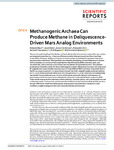2020-01-08Zeitschriftenartikel
Methanogenic Archaea Can Produce Methane in Deliquescence-Driven Mars Analog Environments
Maus, Deborah
Heinz, Jacob
Schirmack, Janosch
Allesandro, Airo
Kounaves, Samuel P.
Wagner, Dirk
Schulze-Makuch, Dirk
The current understanding of the Martian surface indicates that briny environments at the near-surface are temporarily possible, e.g. in the case of the presumably deliquescence-driven Recurring Slope Lineae (RSL). However, whether such dynamic environments are habitable for terrestrial organisms remains poorly understood. This hypothesis was tested by developing a Closed Deliquescence System (CDS) consisting of a mixture of desiccated Martian Regolith Analog (MRA) substrate, salts, and microbial cells, which over the course of days became wetted through deliquescence. The methane produced via metabolic activity for three methanogenic archaea: Methanosarcina mazei, M. barkeri and M. soligelidi, was measured after exposing them to three different MRA substrates using either NaCl or NaClO4 as a hygroscopic salt. Our experiments showed that (1) M. soligelidi rapidly produced methane at 4 °C, (2) M. barkeri produced methane at 28 °C though not at 4 °C, (3) M. mazei was not metabolically reactivated through deliquescence, (4) none of the species produced methane in the presence of perchlorate, and (5) all species were metabolically most active in the phyllosilicate-containing MRA. These results emphasize the importance of the substrate, microbial species, salt, and temperature used in the experiments. Furthermore, we show here for the first time that water provided by deliquescence alone is sufficient to rehydrate methanogenic archaea and to reactivate their metabolism under conditions roughly analogous to the near-subsurface Martian environment.
Dateien zu dieser Publikation

